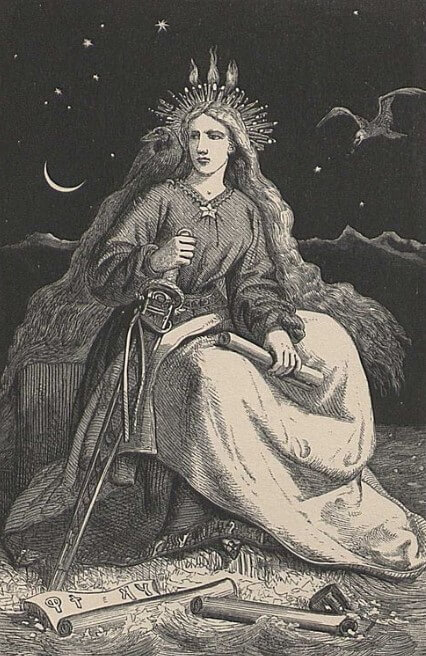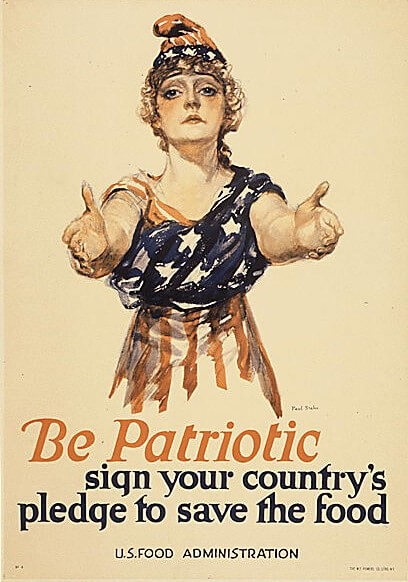From Colombia to Uncle Sam: The History of the American Symbol
Storms and hurricanes, floods and earthquakes, volcanoes and forest fires, snow avalanches, blizzards and bitter frosts, droughts and sandstorms, epidemics and sudden diseases - the origin of all these phenomena could not be explained, and therefore they inspired horror and fear in our ancestors, led them into despondency and despair. In search of help and protection, they turned their gaze to idols and gods, magicians and sorcerers, princes and emperors. In the hope that someone can become their benefactor, intercessor and patron, provide support, explain, save and heal. Belief in these unlimited possibilities led in many countries of the world to the search for national symbols, which over time could change or give way to others. Most often, they gradually transformed, acquired different features, and became exponents of national mentalities, hopes, traditions, but most often - new times. America was no exception in this series. One can even trace an approximate series of transformations of these symbols: Columbia, Brother Jonathan, Johnny Slave, Billy Yankee, Lady Liberty and, finally, Uncle Sam.
In this regard, a special term is most often used - national personification. It implies a personified image of a nation or state, which has been traditionally used in culture and government propaganda for centuries. This word has long-standing Latin roots and consists of two parts: the first is persona, or “personality,” and the second is facere, which translates as “to do.” Those. personification is the creation of a personality. The term was originally used to refer to the ability to impart human properties to inanimate objects or natural phenomena. In other words, “personify” them. Even in Ancient Greece and Rome, this definition could easily be applied to the creation of images of titans, gods, or magical animals that could speak, think and empathize like ordinary people. Therefore, the concept of personification is most often found in religious treatises, myths and fairy tales, fiction, animated films and science fiction films. As the great Voltaire once joked, “If God created us in his own image and likeness, then we were able to answer him in the same way.”
Since those ancient times, the language of fables came to us and the "aesopes", in which animals and birds freely communicated with each other, like people. It should be noted that the literary tradition of the use of personalized imagery continues to live today.
In the storyteller Andersen, the persistent tin soldier pines for his dancer, like a real lover. In Gorky, “the sea was laughing”, and in Mayakovsky in the port:
"Boats pressed into the cradles of the entrances
To the nipples of iron mothers.
In the ears of huge steamers
The anchor earrings were burning.
And who among us does not remember the crow, who Edgar Poe speaks with the main character:
“The bird answered clearly, and at least there was little point.
I wondered with all my heart at her response then.
And who will not marvel at, who with such a dream will become akin,
Who would agree to believe that somewhere, when -
He sat over the door talking without hesitation, without difficulty
The raven with the nickname: "Never."
Therefore, there are many nations, for which the use of images of birds and animals has been fixed as a national personification. One of the most famous among them is Francewith her "Gallic rooster".
The history of this symbol is quite interesting. The fact is that in ancient times on the lands of modern France, Belgium and Northern Italy lived Celtic tribes. Roman historians have brought to us the description of their warriors: tall, stately and slender men, with beards and stacks of red or white hair on their heads, which fit in some very special way, and resembled from a distance the crests of roosters. One can imagine how the Romans were amazed by their appearance, somewhere around the beginning of the first century AD Perhaps because of their appearance, but most likely, due to the special fighting qualities of character, the Romans began to call the Celts Gauls. Since then, the Latin word "gallus" means not only "gall", but also "rooster". Over time, the French began to mint his image on coins, banners, shields, handles of blades and swords. Perhaps this is just a beautiful legend. But the French still believe that the rooster is a symbol of struggle and battle, independence, freedom and cockiness, as well as, to some extent, arrogance. Therefore, the National Olympic Committee of France made it its emblem.
And national teams Australia in football, tennis and cricket they use in their attributes a national symbol - "Boxing kangaroo". For such a strange name, he should be grateful to the kangaroos themselves, who, during a fight with the enemy, push him away with their front paws, and with their more powerful hind paws they deliver crushing blows, from which the enemy receives serious damage or even dies. The sight of such a fight creates the impression that the kangaroo is “boxing” - hence the famous image of the “boxing kangaroo”. At first it was used by traveling artists and circus performers. Then he began to be exploited in silent films and numerous cartoons, which finally connected him with Australia. During the Second World War, the “boxing kangaroo”, thanks to its qualities: the ability to take a punch, durability and readiness to win, became a symbol of the Royal Australian Air Force, appearing on the fuselages of aircraft. Later, the Royal Navy also used this symbolism.
Of course, there are still many similar national symbols in many countries: the Unicorn of Great Britain, the Abyssinian lion of Ethiopia, the Swedish elk, the Belarusian bison and many others.
However, in this type of symbolism the figure is the most interesting for us. Russian bear - personifying Russia. It existed in national folklore from time immemorial. On a par with a hare, a cunning fox, a vicious wolf, etc.
Since there were no elephants or lions in the Russian forests, the bear was the largest and most important beast here, a kind of “master of the taiga”. Therefore, in Russian fairy tales and epics, he was given a special place. Gradually, his image appeared on coins, seals and emblems in different parts of Russia. But turning it into a national symbol served as a tricky case. In 1526, the winter was exceptionally cold. It was at this time that the Austrian ambassador Sigismund Herberstein had to cross the state border with Russia. Later, in his book “Notes on Muscovite Affairs” published by him, he would describe what he saw: “Bears, instigated by famine, left the woods, ran everywhere in the neighboring villages and broke into houses. Seeing their crowd, the villagers fled from their attack and died of cold outside the house with a pitiful death. ” The authority of the ambassador was so high that in the next century a lot of memories of Russia appeared in Italian, English, Polish, German, Dutch and other languages where this story was reproduced.
Thus, a local incident that occurred on the border of Russia in the harsh winter in the 16th century turned into a popular legend about bears running around the streets of Russian cities. And permanently entrenched in historical memory. A little later, as the taming of wild animals, it became clear that bears are easy to train. And then the towns of Russia and Europe were filled with a huge number of buffoons with bears, as well as circuses, without fail including work with bears in their repertoire, where bears acted as acrobats, jugglers, equilibrists, clowns, and later roller-runners, cyclists and even motorcyclists . Since the trainers' performance took place most often under the auspices of the “Russian circus”, this even more “connected” in the minds of Europeans the concepts of “Russian” and “bear”. Therefore, over the centuries, this image was associated by them with aggressiveness, strength, cruelty and backwardness. In recent decades, as opposed to them, such features of a bear as awkwardness, good nature, ingenuousness gradually began to be cultivated in consciousness. And now it rises above the Moscow stadium, under the sad song of Pakhmutova, the symbol of XXII games - a happy, smiling Olympic Bear. And in the cinemas of the world, with ever-increasing success, the show of the animated series “Masha and the Bear” continues, about the adventures of a little girl who has made friends with a big and good-natured beast.
But stereotypes over the centuries have been so firmly entrenched in consciousness that it will take a lot of time and effort to change them in any way.
However, the image of animals or birds in the national symbolism of different countries is not very common.
The most widespread appeal to the female image. And this is easily explained: the famous psychologist Sigmund Freud, like the American researcher Harry Sullivan, noted the special role of the mother in the process of personality formation. From this comes the assumption that the son often chooses a bride similar to his mother. The familiar appearance and manner of communication from childhood are a signal to him what exactly come from here his safety and protection. And the one who looks like a mother will understand and console everything. So gradually, this image begins to appear in the national symbolism. At first, it is in the image of "Motherland". Or in the form of a beloved, most often associated with the ideas of youth, hopes, liberties of spirit and expectations of change. It may also be presented as a Virgo, associated with the idea of purity and purity.
Female images as symbols of the nation
It is known that among the 12 gods of Ancient Greece there were three women: Hera - the wife of the almighty Zeus, Aphrodite - his daughter, and the most revered among them - Athena. The story of her birth is completely unusual - she was born from the head of Zeus in full combat uniform. That is why she was considered primarily the goddess of just war and wisdom. This warrior maiden was also the goddess of knowledge, arts and crafts; patroness of cities and states, sciences and craftsmanship, intelligence, dexterity and ingenuity. In addition, it was believed that she protected sailors and shipbuilders, and was a mentor to weavers, metal and woodworkers. She was a healer and protector of married women.
This most beloved and respected resident of Olympus was depicted, as a rule, as a tall, fair-haired woman with classic facial features, large gray eyes and ideal posture. Unlike other goddesses, we always see her in armor: with a spear and shield in her hands, as well as a helmet with a high crest on her head. Of course, his visor was raised. After all, everyone should have seen and enjoyed her divine beauty. Sometimes, an owl or a snake was placed at Athena’s feet as symbols of wisdom, and in her hand was a small sculpture of Nike, the personification of Victory. It is believed that it is with the figure of the goddess Athena that the countdown of the depiction of female images in the symbolism of different countries of the world begins.
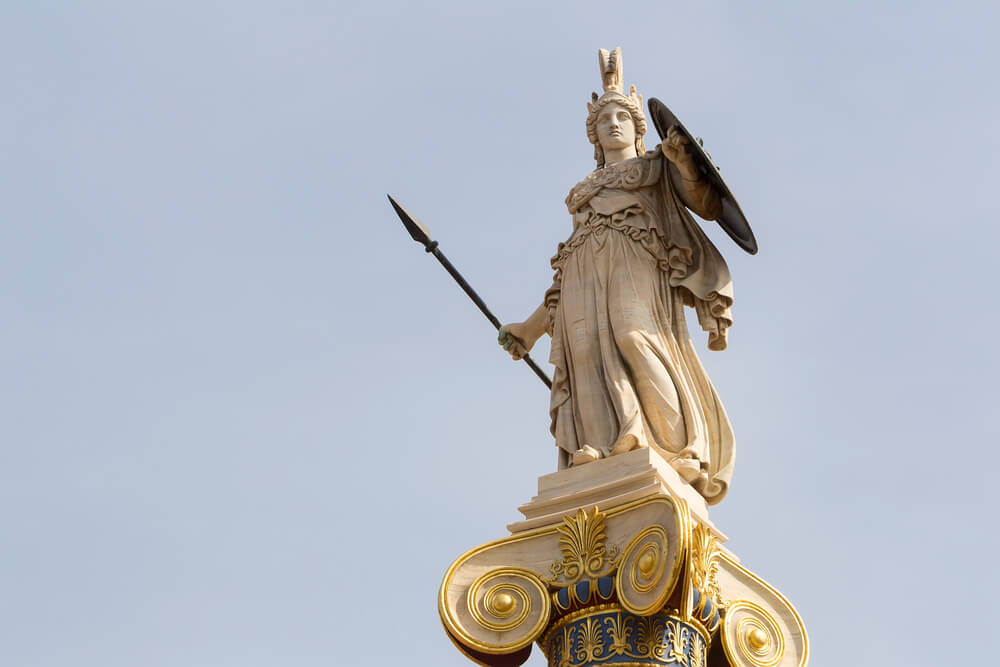
Фото: Depositphotos
Soon the civilization of the Ancient Greeks was replaced by the Roman, and then the empire of Charlemagne, who spread the ideas of Christianity throughout Europe. And because for a long time in her group identity was not that “Italian” you or “Dutchman”, but you are a Catholic or a heretic. Later, Catholic or Protestant. But after the bloody thirty-year religious war of 1618-1648, when the boundaries of states were clearly defined, there is a fundamental shift in the search for national identity, culture, language and historical community. What will later be called "national priorities."
Great Britain. Britannia. Lady britain
This was especially evident in Great Britain. There appeared its own national flag - “Union Jack”, then a national anthem - “Rule, Britannia”, glorifying not so much the monarchy as the community, or the nation. And then the image of the symbolic image of the country - Lady Britain. Her ancient name, implying the feminine gender, was given to the country by the Romans. With the light hand of Queen Victoria, the figure of Britain began to be depicted wearing a helmet, with a trident and a shield in hand, as a symbol of the winner and founder of a huge maritime power. And the lion, perched at her feet, seemed to confirm her power and significance. On British coins she is depicted sitting on a chariot, looking forward into the future.
Sweden. Moder Svea (Mother Sweden)
As a rule, depicted as a powerful warrior with a shield in her hands, standing next to a lion. Svea is the national female name, which derives from the outdated grammatical form of the name of a people and country (Svea - Svea rike - Sverige). Unfortunately, Svea is not the goddess of the ancient Vikings. This is a collective image that personifies the national personification of Sweden.
As a national symbol, it appeared in 1672, thanks to the Swedish diplomat Anders Leijonstedt. In his youth, he composed a poem, which he called "The Triumph of Svei" (Lycksaligheets Triumph). And later 25 years, another Swedish poet Gunno Dahlstierna (Gunno Dahlstierna) borrowed this image as a patriotic symbol in the work, glorifying the Swedish king Karl XI. From this moment on, Svei becomes a widely used patriotic symbol of Sweden: a warrior standing guard over her homeland with a shield, a sword and a lion lying at her feet. She put the sculptures and monuments, and its bas-reliefs carried on the banknotes and coins.
Iceland. Fjallkonan (Fjallkonan).
As a national symbol, it embodies the Icelanders' desire for independence, the beauty and nature of the country. The “Lady of the Mountains,” as she is often called, is depicted as having blonde hair (like most Icelanders), wearing a blue or black dress and a light-colored headdress. She was first described in the poem Ofsjónir by Eggert Olafson (1752), but her name became widely known thanks to the poem Eldgamla Ísafold by Bjarne Thorarensen. From this point on, she becomes the most famous symbol in Icelandic poetry. Since the founding of the Icelandic Republic in 1944, the reading of the poem "Mistress of the Mountains" on Independence Day (June 17) has become a tradition. Then a beautiful woman is chosen, who, wearing a festive Icelandic national costume, in the image of the Lady of the Mountains, recites this work, to the warm applause of all participants in the holiday.
France. Marianne.
The symbol of the republic since the Great French Revolution. It was then, in September of the 1792, that the National Assembly of France decided that the new state’s press should have an image of a woman with a spear, and a Phrygian cap on her head. This headgear was known from the time of the Roman Empire, where liberated slaves wore it. Since then, Marianne has been portrayed as a young woman in this cap, personifying the national motto of France, Liberty, Equality, Brotherhood. Many French artists recreated it in their works. One of the most famous among them is Delacroix's Freedom on the Barricades, painted under the impression of the 1830 revolution of the year. Marianne's profile is not only on the state seal, it is also depicted on French standard postage stamps.
And the sculptural images of Marianna are a mandatory attribute of the institutions of government, courts, municipalities and so on. Initially, these were busts, with a reflection of a certain collective image, but since 1970, new rules have been introduced. The committee of mayors of French cities, as a prototype of Marianna, began to elect one of the famous beautiful women of the country. The first of these in 1968 was the movie actress Brigitte Bardot.
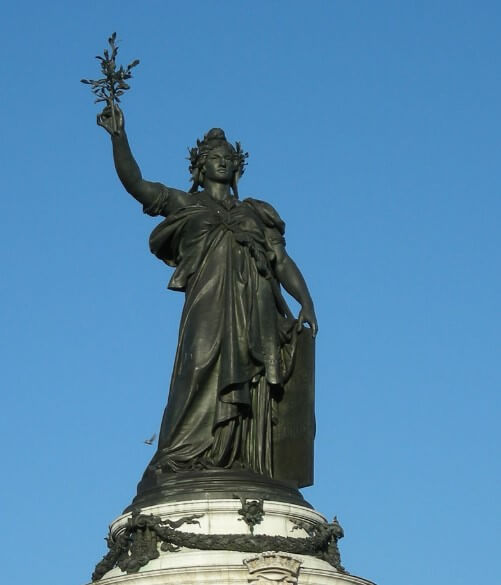
Photo: wikimedia.commons / flickr
Switzerland. Helvetia (Helvetia)
The name of the female symbol of the country comes from the Latin name for the north-western part of modern Switzerland, in ancient times inhabited by the Helvetians. Called the mother of the Swiss people, she is usually depicted in a flowing dress, with braided hair, holding a spear and a shield decorated with the national flag. The wreath on her head symbolizes the Confederation.
In 1672, Johann Caspar Weissenbach showed his new play Eydgnoßsisches Contrafeth auff-unnd abnemmender Jungfrawen Helvetiae, in which he created the image of Helvetia, the figure of subsequent identification of all Swiss citizens, regardless of their language and religious affiliation.
And on postage stamps and coins of the country, the neutral name of the country began to be used - Helvetia, so as not to give preference to any of the four state languages. For the same reason for license plates cars was chosen neutral country code CH, or Confoederatio Helvetica (Helvetica Confederation).
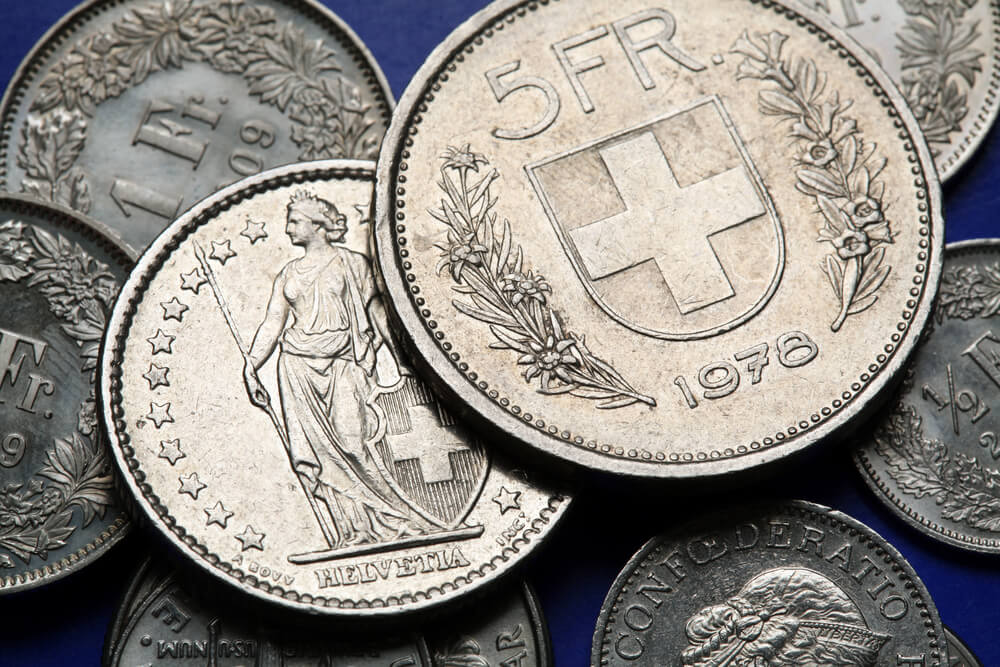
Фото: Depositphotos
At the end we will remind you a sculpture Motherland is callinginstalled in Russia in 1967 (Volgograd), and Motherland in Ukraine (Kiev) in 1981
And here we have the image of the National personifications of France, Russia and Britain on the poster of the times of the First World War.
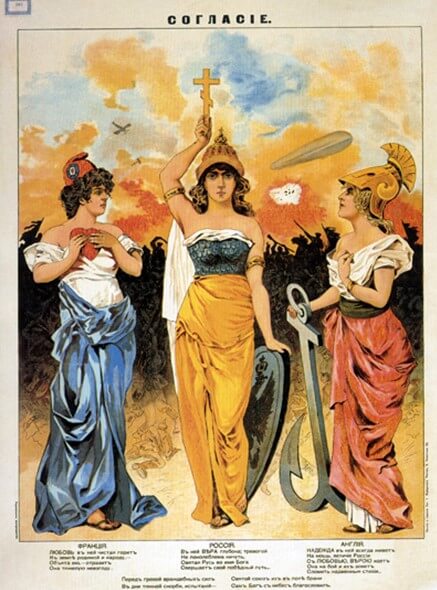
Photo: wikipedia, public domain
America. Columbia (Miss Colombia).
It is believed that her name was first officially pronounced in 1697 by the Chief Justice of the Massachusetts Supreme Court, Samuel Sewell. According to other sources - during the debates of the British Parliament in 1738 - it became increasingly obvious that the settlements of new colonists on the distant continent should have been given some name. With the light hand of the famous cartographer Mercator, the continent itself has been called America for a long time. The mistake made and its true discoverer, Columbus, have been known for a long time. So why not introduce the feminine transformation of his name - Columbia? Thus, since 1784, one of the most prestigious universities in the country received a new name - Columbia. Like the sailing ship on which Captain Robert Gray began exploring the inland waters of British Columbia (now the states of Washington and Oregon) in May 1792.
Since then, until our time, this name was exploited quite often. Starting from the founding fathers, when George Washington called Colombia a government district. By the way, the river flowing alongside in Washington state also bears the name of Columbia, as well as the lake from which it begins its journey. This is the name of 15 of large cities in the country, not counting the large number of small villages and other settlements, and in them the names of many streets and avenues. It is impossible not to name the mountain, the glacier, the plateau and the two islands, as well as many enterprises proudly bearing this name. It should be recalled that the command module of the Apollo 11 spacecraft, which had landed on the Moon, was also called Colombia, just like the first Shuttle, built in 1975 – 1979.
This name has become so firmly ingrained in the consciousness of the people of the country that, by analogy with Britain, the Americans did not hesitate to call their female symbol Columbia. However, to the greatest regret, her appearance and image were neither officially recorded nor consolidated by tradition. She was most often depicted as a young woman wearing classically draped garments decorated with stars and stripes (the most popular version is a red and white striped dress and blue blouse) and a scarf or belt decorated with sequins and white stars. Her headdress also changed frequently, sometimes including feathers reminiscent of a Native American headdress or a laurel wreath. But most often it was a Phrygian cap. These differences in its external appearance can be easily traced by the change in the logo of the American film company CBC Film Sales Corporation, which, soon after its formation, decided to use the image of Columbia in its advertising, even changing its name to Columbia Pictures in 1924. Initially, Colombia was depicted in the logo with a laurel wreath, an olive branch and a shield, reminiscent of the image of a Roman warrior. Then a torch, probably inspired by the Statue of Liberty, appeared in her outstretched hand, and a Phrygian cap appeared on her head, but the shield disappeared. In subsequent versions, she was already placed on a pedestal, and looked like a beautiful young woman with a strict hairstyle, in a snow-white tunic, with a striped or blue cape flowing from her shoulder.
The sculptural images of the female symbol of the country are also different: from a proud warrior and defender, whose six-meter-high figure crowns the dome of the Capitol building in Washington, and the figures of the victor and the winner, the so-called. “Golden Lady”, set up in Jackson Park in Chicago, before mourning for her dead sons at the National Memorial Cemetery of the Pacific in Honolulu, Hawaii.
Nowadays it is difficult for us to imagine what a huge role the figure of Colombia played in the consciousness of Americans for a long time: from the beginning of the wars for the country’s independence until the 20s of the last century. It was present in the speeches of politicians and presidents, on the pages of newspapers and magazines, in political cartoons and pamphlets. Colombia rejoiced, joked, criticized, was indignant, hoped and mourned with all the people. Artists, writers and journalists used it to inspire millions of people in the fight for American ideals. After all, the main anthem of the country in those years was the song Hail Columbia (“Long live Columbia”), which then gave way to the leadership of the Star-Spangled Banner, remaining the march of the Vice President of the United States of America. It was first performed under the name “Presidential March” (music by Philip Phile, lyrics by Joseph Hopkinson) in 1789, at the inauguration of George Washington. Not with the name of the leader, as it would later be in Germany or Russia (“Heil Hitler,” or “for the Motherland, for Stalin”), but with the words “Hail, Columbia,” American soldiers went to the battles of the First World War. “Long live Colombia, happy land. Long live the heroes who fought and shed their blood in the struggle for freedom…”, so sang the young Americans leaving for the front. This symbol of America - Colombia, was then associated with activity, power, power, the desire for expansion, i.e. with those qualities that are traditionally interpreted as masculine. And therefore, over time, the sympathies of Americans began to gradually lean more and more towards male symbols. But for a long time they existed simultaneously.
At least, the famous cartoonist Thomas Nast, in his publications, gave her even more space than Uncle Sam. But as time went on, her popularity and attractiveness were intercepted first by her brother Jonathan, and then by her uncle Sam. A place of the "female" symbol of the country confidently took the Statue of Liberty, located for centuries at the entrance to the harbor of the New York port. Oddly enough, but definitely unfavorable The use of Colombia as the logo of the same-name film studio played a role in this. As we have said, they are constantly changing and "improving" her image. As a result, she turned into an amazingly beautiful, slim woman, with an elegant haircut and a cape casually slung over her shoulder. But the self-asserting, ambitious and rushing nation of leadership, wanted to have as its symbol not just a pleasant woman, but an energetic, business-like, tough and strong-willed figure that would embody the best features of both Britain and Marianna. Such a woman was embodied by Bartholdi in the Statue of Liberty. So, gradually giving up the position, Colombia eventually gave way to the Statue of Liberty and Uncle Sam.
Male images as symbols of the nation
Of course, in the world there are a huge number of male figures claiming to become the leading symbols of the national personification of the country. However, if female images to some extent originating from the goddess Athena (after all, Colombia also rarely removes its snow-white tunic) most often have the functions of patroness, protector and intercessor, counselor and protector of the earth and hearth, then “male”, as usually perform a completely different function. These are some characters that most often come from the pages of epics, or literary works, are carriers of folk wisdom, all kinds of folklore, jokes, poems, rude humor, or anecdotes. Such “simpletons” who fall into different difficult situations and rework, but always find a way out of them, depending on their national mentality and characteristics. We will tell about some of them.
Germany. Deutscher Michel (Michel)
Of course, there are many legends about the birth of this character. Authorship is attributed to Sebastian Frank, who allegedly launched it into circulation in his collection of proverbs and sayings (1541). There is also an opinion that the glory of the combat commander of the times of the thirty-year war (1618-1648) Hans Michael von Oberteraut, nicknamed "Michael Germanicus", contributed to its spread. However, the most plausible is the assumption that during the period of the Middle Ages, when Germany adopted Christianity, the archangel Michael was considered the patron saint of the empire, and therefore very many boys received this name at baptism. Over time, it became perceived by foreigners as a stereotype (like Ivan in Russia). In those days, in the country, the difference between educated wealthy people and ordinary people was observed more and more sharply: illiterate citizens and peasants. They were perceived by the nobility, and even by the middle class, a sort of near-minded simpletons, who, despite the stupidity, are able to endure many hardships and hardships. Thus, Michel gradually established an image of the simple-minded, stupid, limited and not interested in politics. Bosch, beer club, cabbage eater, etc. Therefore, the essential attributes of the appearance of Michel are a simple or nightgown, with a nightcap (or cone-shaped with a tassel), indicating a docile nature and purely peaceful philistine features. And although during the Second World War and later, this image turned out to be unclaimed, but recently it has again appeared on the pages of comic magazines and in political satire.
Canada. Johnny Canuck (Johnny Canac)
In 1869, a cartoon came out in Canada, in which this amazing hero first appeared - Jenny Canac. This word itself - canuck, is associated with those people who work in the forest. Hence, this “Canadian lumberjack” has corresponding attributes: a beard, a plaid shirt or a sweater, a slanting sazhen in the shoulders, and, of course, an ax. Later, when this symbol is used in hockey, the ax will be replaced with a stick. In the entire history of the existence of this symbol of the national personification of the country, it has been changed several times. But most of all (almost 30 years) was used in political animation, where Jenny Canak acted as a lumberjack, farmer, rancher or soldier.
During the Second World War, as a captain, Canac will wear red and white tights, and a Canadian maple leaf will appear on his helmet. As we have said, in the middle of the last century, the well-known professional hockey club “Vancouver Canadians” will decide to use its figure as its emblem, while wearing it in hockey uniforms. And in the 1995 year, when Canada Post released a series of Canadian postage stamps, Johnny Canac was wearing a bomber jacket, leather headgear and boots. So time, constantly running forward, changed the image of this Canadian hero.
England. John Bull (John Boole)
In 1727, the pamphlet of the English publicist John Arbuthnot, “The History of John Bull,” was published here - a witty allegory intended to ridicule the Duke of Marlborough and cool the British desire for war with France. There is an opinion that the idea of its creation was suggested to the author by the writer Jonathan Swift, an active member of his “Martin Pisaki Club”. And the name itself, John Bull, was not chosen by chance by the author. To personify the image of England, the name of the court organist of Queen Elizabeth, the author of the English anthem “God Save the King,” was used. The image of John Bull created by Arbuthnot became especially popular after the premiere of John Colman the Younger's play John Bull, or the Family Life of an Englishman (1803), staged at the Haymarket Theatre.
Since then, in numerous cartoons and sketches, John has been portrayed as a stocky, red-cheeked, red-haired fat man with a sly face - a patriot who despises everything un-English. At the same time, he is rude, stubborn, but gifted with common sense. With the obligatory sideburns, in a red frock coat, white trousers or leggings, a short top hat or cap. Sometimes with a telescope. During the reign of King George, the character wore a red waistcoat and royal blue tailcoat. He was often accompanied by an English bulldog - a dog that perfectly suited John Bull in character and appearance. For the British themselves, John Bull was the personification of the strong, healthy and businesslike aspects of the national character, above all energy, honesty and decency. Other peoples saw in this symbolic figure not only positive traits, but also negative ones characteristic of the British colonialists: self-interest, arrogance and an arrogant attitude towards other peoples. However, its literary or pictorial incarnations are a vivid illustration of a very special English character and English humor.
Remember how in the poem by the Soviet children's poet Vadim Levin, about an English professor who leisurely watching his colleague drowning in the river, before coming to the rescue, asks: “Excuse me, Bul, It’s July, Is the water warm? Bul-bull, said Professor Buhl, which meant “Yes.”
America. Uncle Sam (Uncle Sam)
Looking at these joint caricatures of John Bull and Uncle Sam, it seems that one of the main tasks of the artists creating the image of Uncle Sam was to find a character diametrically opposed to John Bull. Long and short, thin and fat, with and without a beard, with long disheveled hair and a short haircut. At the same time, with a high and low cylinder on the head, and clothes that include national symbols. But it is not so. Because the image of Uncle Sam was not born out of nowhere. It carried over some details from the image of Brother Jonathan, a folk hero associated with New England during the Revolutionary War.
Brother Jonathan (Brother Jonathan)
On the pages of newspapers and magazines, in political cartoons and posters, he was usually depicted dressed in striped trousers, a dark coat and a hat-cylinder. It is believed that his prototype was Jonathan Trambull (1710 — 1785), the governor of Connecticut, friend and associate of General Washington during the War of Independence. General Treasurer of the Continental Army. There is a legend that allegedly George Washington, when he had problems with the supply or recruitment of the army, always said "Now you should consult with Brother Jonathan." This phrase soon became “winged”, and army jokers made it especially popular. Once in the newspapers, the image of Brother Jonathan was first cultivated as a character who knows the answers to all questions and is able to solve any problem, and then began to be perceived much more widely. Be that as it may, but in the period from 1783, and until the Civil War, this image was very popular among the Americans of New England.
Johnny Reb And Billy Yank (Johnny Reb and Billy Yank)
But time passed, and gradually the contradictions between the North and the South began to grow. And by the beginning of the Civil War, the mentalities of southerners and northerners were already significantly different from each other. As American history professor Grady McWeeney of Texas Christian University puts it: “In the antebellum period, many observers described Southerners as more hospitable, generous, frank, courteous, lazy, desperate, warlike, wasteful, impractical, and reckless than Northerners, who , in turn, were more thrifty, shrewd, disciplined, awkward, enterprising, greedy, cautious, modest, ambitious, peaceful and practical than the inhabitants of the South.” Naturally, Brother Jonathan, the favorite of New England, could no longer single-handedly express all the feelings and aspirations of the warring parties. Therefore, during this period, his image “bifurcates”, and he dissolves into the figures of new heroes: “southerner” Johnny Reb and “northerner” Billy Yank (hence the offensive nickname “Yankee”, which has come down to our times). Their figures became so popular that the war itself began to be called the Johnny and Yankee War, and their images were used for propaganda and political purposes. In this regard, the song Gene Autry - Johnny Reb And Billy Yank is especially interesting:
"Oh, Johnny Reb and Billy Yankee
Do not you want to go back to fishing
Someone to the north, and someone to the south
Return to your old home circle
To your Virginia home, Johnny Reb
And a house in old New England, Billy Yankee. ”
And they, in the end, tried to “return” to the united country after the war, then they were no longer in demand there. A new figure was needed, already expressing common values and ideals.
And she is born again, like Brother Jonathan, into the army. And the following happened: in 1812, in connection with the outbreak of the Anglo-American War, when the demand for meat products in the army increased significantly, Secretary of War William Eustice signed an annual contract with an entrepreneur from Troy (a town in eastern New York) - Samuel Wilson , to supply a large batch of them to the troops. The choice fell on Wilson due to the fact that by that time he already had a successfully operating enterprise for the production of meat products. Its workshops and piers were located on the banks of the Hudson River, from where products could be quickly delivered to the army and military depots in Greenbush. Samuel's responsibilities also included checking the quality of meat for the Northern Army, packaging it, accounting and labeling all barrels of product. For patriotic reasons, he marked the kegs with a stencil “US”, which meant United States. However, most of the soldiers from the units stationed there were residents of nearby places, and many even from Troy itself. They knew very well not only the products produced by Samuel Wilson, but also himself. And therefore, they were firmly convinced that the letter abbreviation “US” on the packaging of meat barrels means nothing more than Uncle Sam (Uncle Sam). And therefore, if somewhere there were delays in the delivery of meat products, the young fighters confidently declared: “Don’t worry, Uncle Sam won’t let you down!” Thus, involuntarily, from the very beginning of the birth of the national symbol, a direct relationship was established between the figure of Uncle Sam and the government of the country.
By the way, the veracity of this legend was officially confirmed on September 15, 1961 by a decision of the US Congress, which stated that Samuel Wilson is indeed the “progenitor” of the national symbol of America - “Uncle Sam”. In this regard, in two cities of the country you can find monuments to this real historical character: in the city of Arlington (Massachusetts) - where he was born, and in Troy (New York) - where he worked and passed away (statue and tombstone monument). And various figurines, busts, bas-reliefs and all kinds of advertising crafts, depicting the already symbolic Uncle Sam, can be seen in huge quantities in many cities of the country.
However, if we take a closer look at the image of Samuel on these two original monuments, we will find that they represent two completely different people. On the first: a figure with a stern, intelligent face and neatly parted hair. And on the second there is an image close to a poster: a man with pointed facial features, a beard, and long flowing hair. This is due to the fact that no image of the real Samuel Wilson has survived. And therefore, it had to be created. The first magazine versions of the “portrait” of the hero began to appear in the press in the first half of the 1870th century. However, it is generally accepted that the basis for the now famous image of Uncle Sam was created by cartoonist Thomas Nast in the XNUMXs. In doing so, he used several details from the image of Brother Jonathan, giving him portrait features of the first and only President of the Confederacy during the Civil War, Davis Jefferson. Nast was a fairly well-known master at that time: he was at the origins of the creation of the genre of American political drawing and animation, was the author of the emblems of the Republican and Democratic parties of the United States - a donkey and an elephant, and was the first to draw the American Father Frost - Santa Claus.
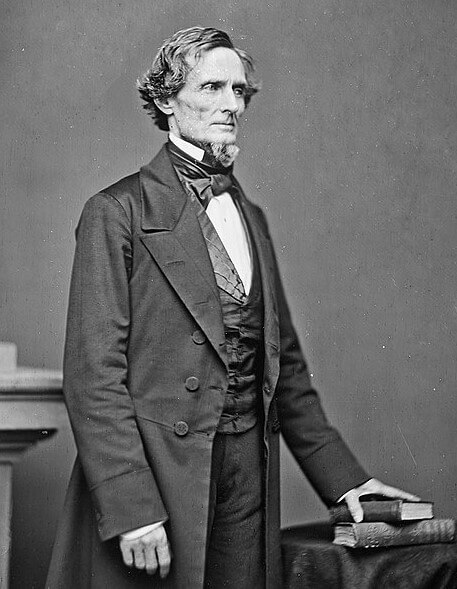
Davis Jefferson. Photo: wikimedia.commons, public domain
Therefore, the image of Uncle Sam he created was immediately accepted by both the public and his colleagues. He passed away in 1902, and therefore, at the beginning of the First World War, this baton was confidently taken up by James Montgomery Flagg, who in 1917, commissioned by the American government, painted a poster, which became not only the peak of his stellar career as an artist, but also brought There are tens of thousands of volunteers in the US Army. His Uncle Sam, whose strong-willed face appeared tough, focused and demanding, addressed the entire nation from a poster: “I Want You' for a US Army.”
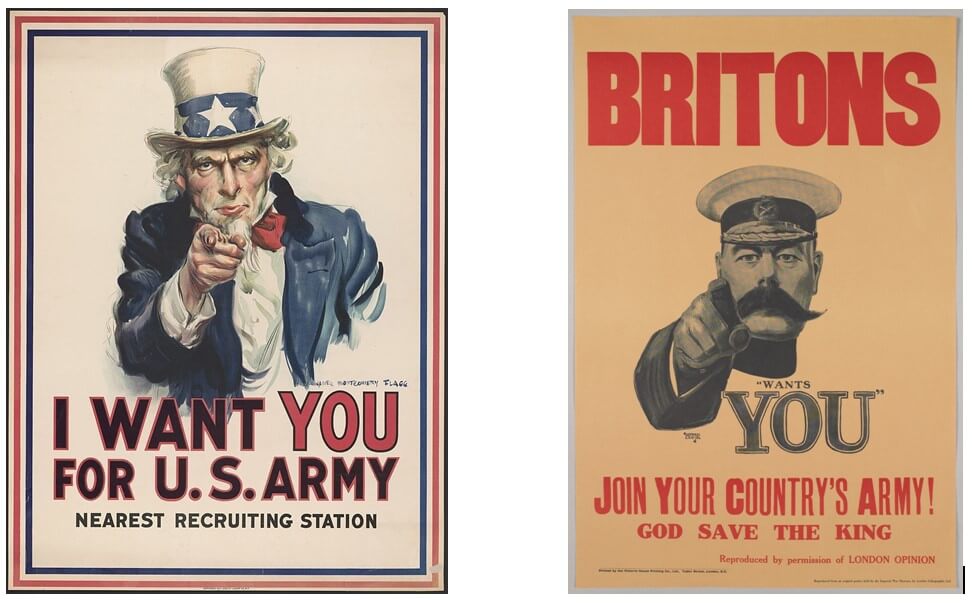
Photo: wikimedia.commons, public domain, public domain
The image was so strong and impressive that it was repeated during the Second World War, and continues to be cultivated until today. In creating this poster, he used the style of the portrait of Uncle Sam, proposed by Nast, but he used his own face as a model, having deliberately aged it. In search of an optimal solution for his poster, he found the work of Alfred Leet, an English colleague, who at the very beginning of World War I (1914) portrayed unceremoniously “poking” his finger at the viewer of the Minister of War Lord Horace Kitchener with the words: “British! Kitchener needs you. Join the army of your country! God save the king! ”This poster made such a strong impression on him that James Flegg decided to use his idea in his work. And yet, the image created by him turned out to be so expressive and memorable, colorful and emotional (from whatever point you looked at this poster, the demanding Uncle Sam will always look you right in the eyes) that he received universal recognition and was replicated many times not only in America, but far beyond.
So, for example, this work by Flagg served as the basis for the creation by Soviet artist Dmitry Mor (aka Orlov) of the famous Civil War poster in Russia - “Have you signed up as a volunteer?”, thereby continuing the series of “finger posters”. Like Flagg, Moore painted himself as a Budenovite, thereby giving this work a more personal character. Later, he recalled it this way: “This poster depicts a Red Army soldier pointing his finger, his eyes are directed directly at the viewer and turn as he goes. I've collected a lot of feedback on this poster. Some told me... that they were ashamed not to sign up as volunteers.” At the beginning of the Great Patriotic War, Moore updated the old poster - now the soldier was with a rifle, wearing a 1938 model helmet and with new pouches, while maintaining the bright red revolutionary color. And soon this idea was borrowed by the artist Irakli Toidze, who created the most famous Soviet poster of the Second World War - “The Motherland is Calling!” (1941).
And here is a German poster from this series: “You should also join the Reichswehr”, created in 1919 for the purpose of recruiting into the armed forces of the Reichswehr. (Engelhard -JU)
Or British, at about the same time: “I want my old land back. Join the Jewish Legion! ”
But back to Uncle Sam. Time is inexorably changing lives, and with it changes the national symbol. During the wars, he called for help to the country, and go to the front. In difficult times, he actively participated in political life, enraging many opponents of the country. There, abroad, he was portrayed as greedy, implacable and angry. But not all. It is said that when, after the pogroms, the Kishinev Jews gathered in the plundered synagogue and discussed the issues of emigration, the most optimistic among them confidently declared: “What are you saying? Of course, we must go! Will Uncle Syoma be able to leave us in trouble? ”
And although life has taught many generations of Americans to struggle and rely only on themselves, somewhere in the depths of their souls there has always been a hope that if completely insoluble problems arise, then Uncle Sam will still come to their aid.
Nowadays he is already depicted in modern clothes, in a tuxedo or even overalls. True, the top hat continues to be an integral part of his wardrobe. Although now he increasingly appears on the stages of musicals, in computer games, cartoons or on cinema screens - most often in a humorous or parody embodiment. As the wars in Korea, Vietnam, and the Persian Gulf are gone, so are the days of McCarthyism, the witch hunts, and the Cold War. But life moves forward, completes its next round, and as paradoxical as it may seem, somewhere on the horizon the winds of war arise again, the silhouettes of the “cold wars” and “witch-hunting” appear again. This means that again and again on the pages of newspapers and magazines, on television screens and in numerous “networks” the figure of Uncle Sam, so well known to us, is becoming in demand.
In 1989, the country's Congress decided to celebrate Uncle Sam Day on September 13 of each year. This date was not chosen by chance, since it was “tied” to the true birthday of Samuel Wilson - September 13, 1766. And if you have a desire to meet not the poster Uncle Sam, or one very similar to him from the Washington Wax Museum, but the real one - alive, in more or less modern clothes, then you should take part in this holiday.
After all, there you will encounter completely unforgettable sensations. Looking at the action taking place there, you understand perfectly well that Uncle Sam is played by well-trained actors. But it doesn't matter. After all, for you, Uncle Sam is not a living person at all, whom you can now approach, touch, and maybe even, having the audacity, pat on the shoulder, or take a photo together. This is a symbol - a personified image of the state, its “machine”, services and institutions. And the poster that you can read next is about exactly this. The long index finger is pointed directly at you, as is the stern and demanding gaze. “Did you think that Uncle Sam was no longer with you? But he's here. He remembers and knows about you!” It cannot be otherwise. He is always near us. The aging but resilient Uncle Sam is a symbol of the country!
This article by ForumDaily author, journalist Leonid Rajewski is part of the “History of American Symbols” series.
Read also on ForumDaily:
The White House: The History of the American Symbol
Dollar: the history of the American symbol
Flag: the history of the American symbol
Statue of Liberty: the history of the American symbol
Bourbon: the history of the American symbol
Apple Pie: The History of the American Symbol
Hot Dog: The History of the American Symbol
Subscribe to ForumDaily on Google NewsDo you want more important and interesting news about life in the USA and immigration to America? — support us donate! Also subscribe to our page Facebook. Select the “Priority in display” option and read us first. Also, don't forget to subscribe to our РєР ° РЅР ° Р »РІ Telegram and Instagram- there is a lot of interesting things there. And join thousands of readers ForumDaily New York — there you will find a lot of interesting and positive information about life in the metropolis.

